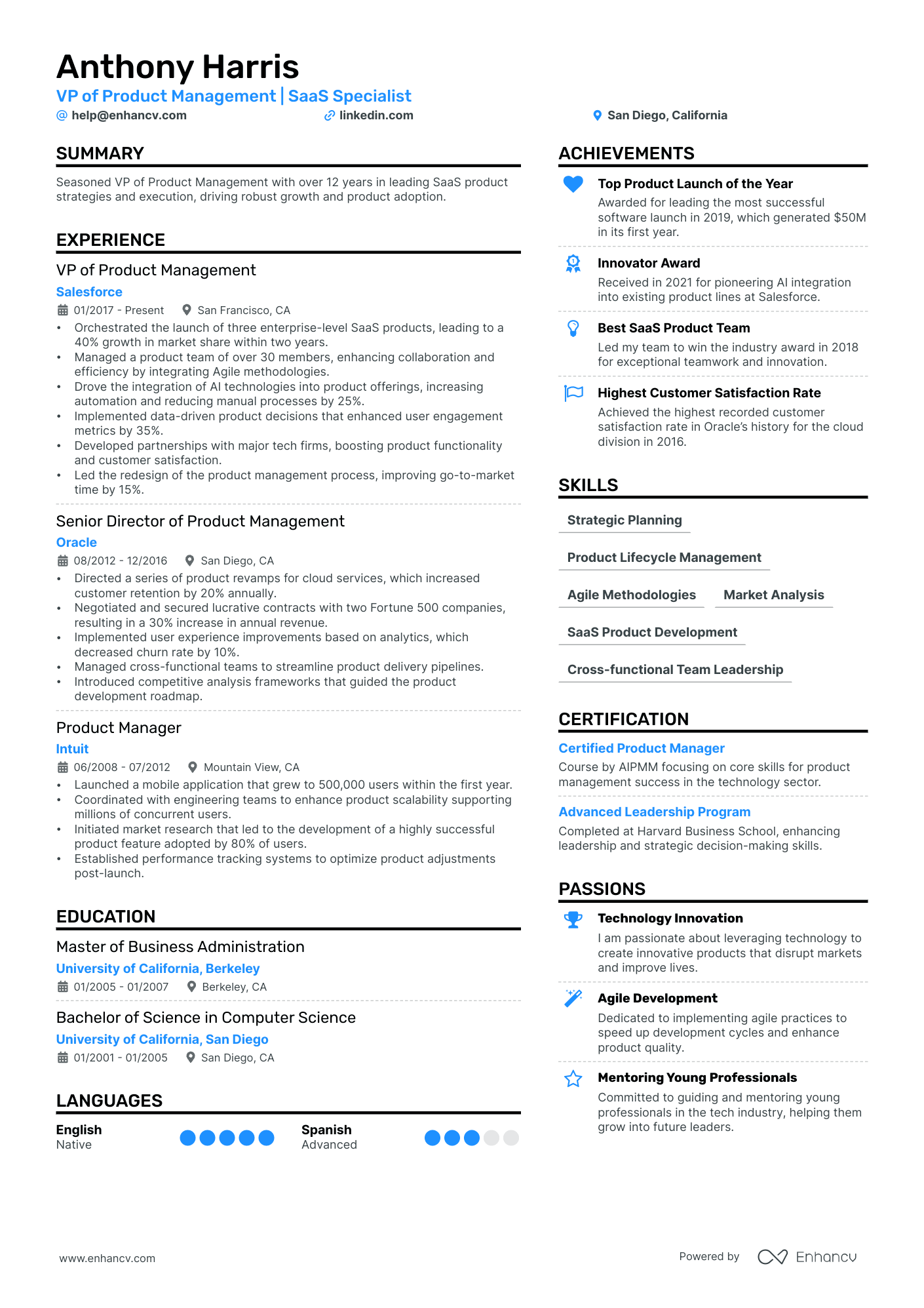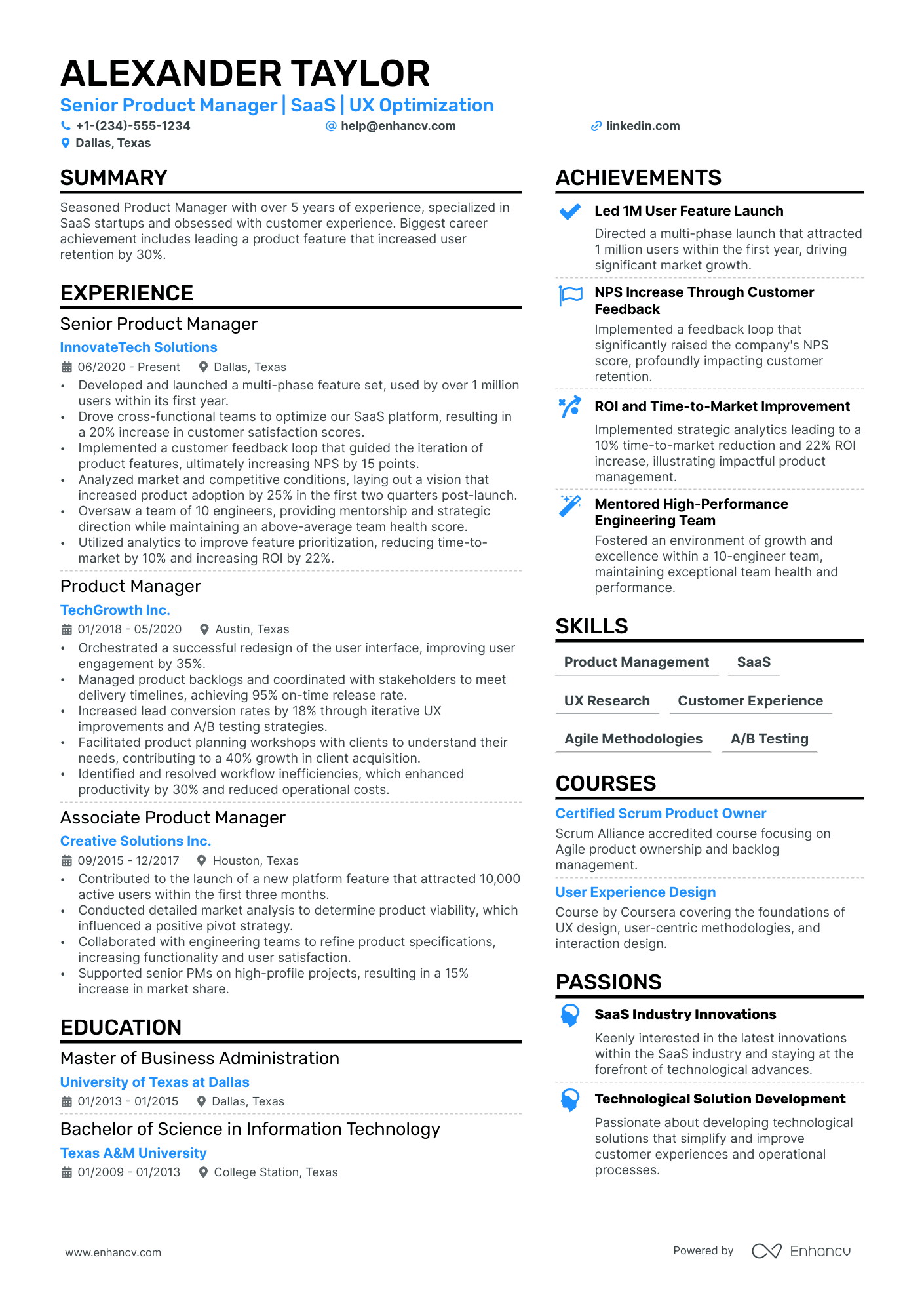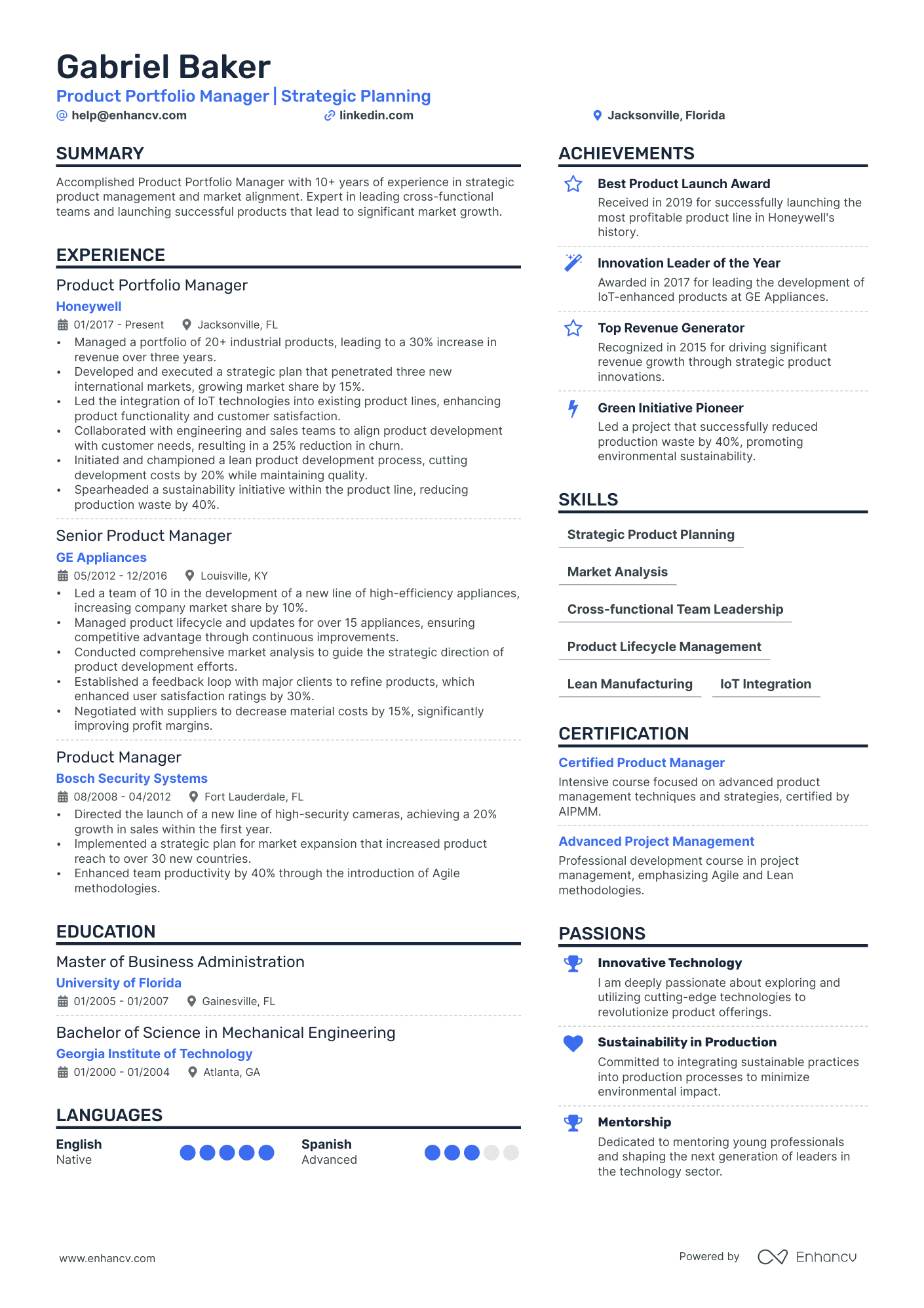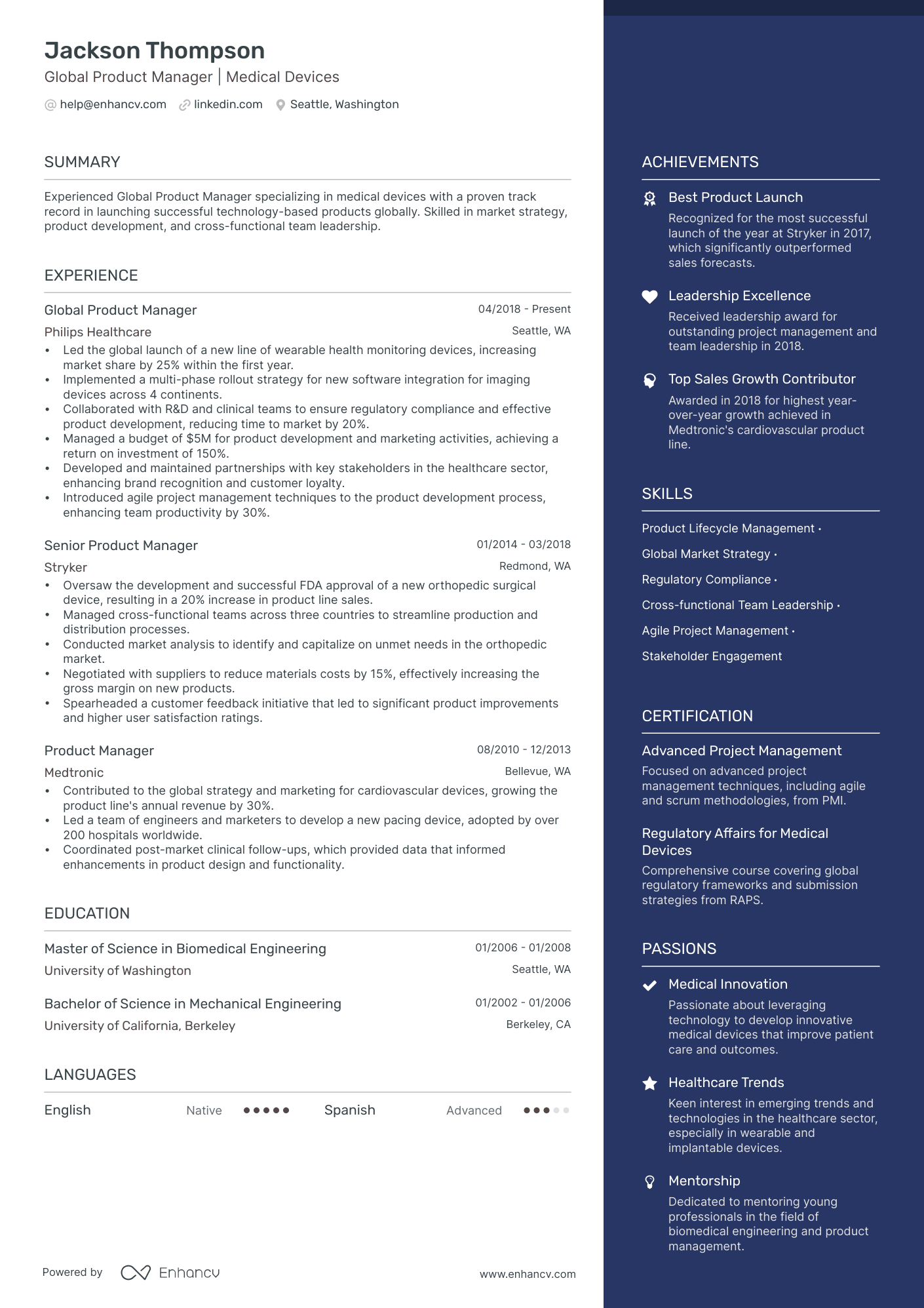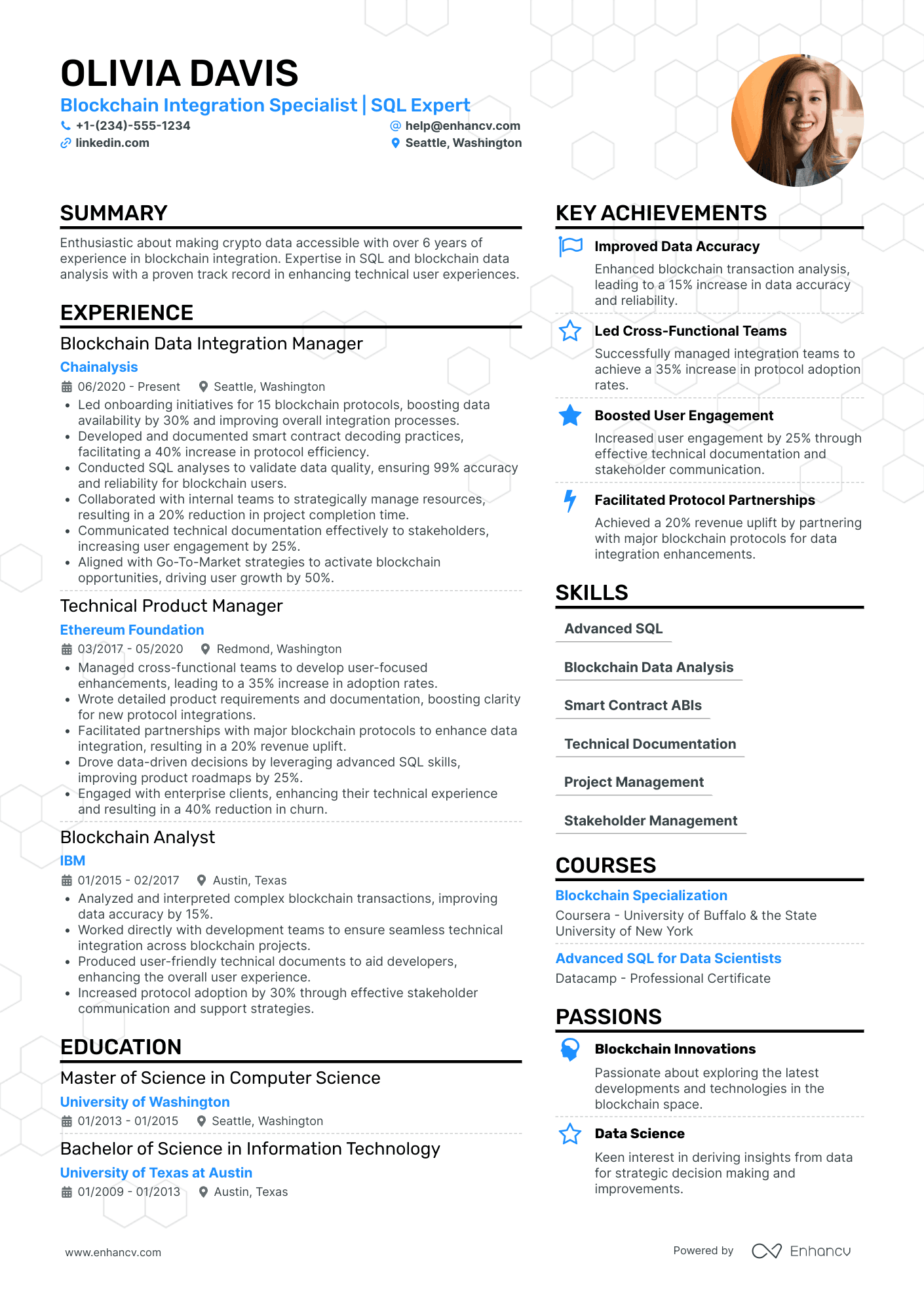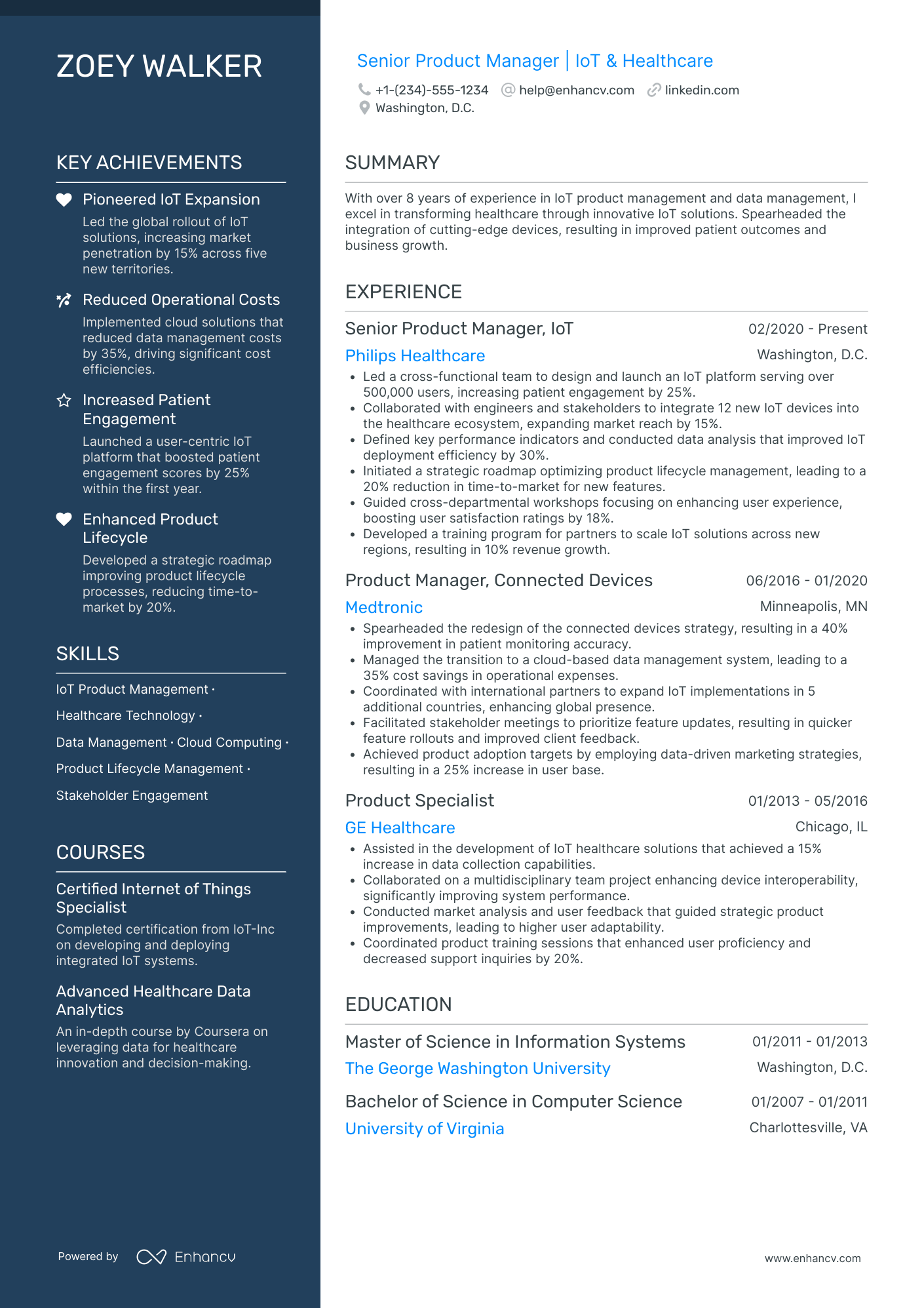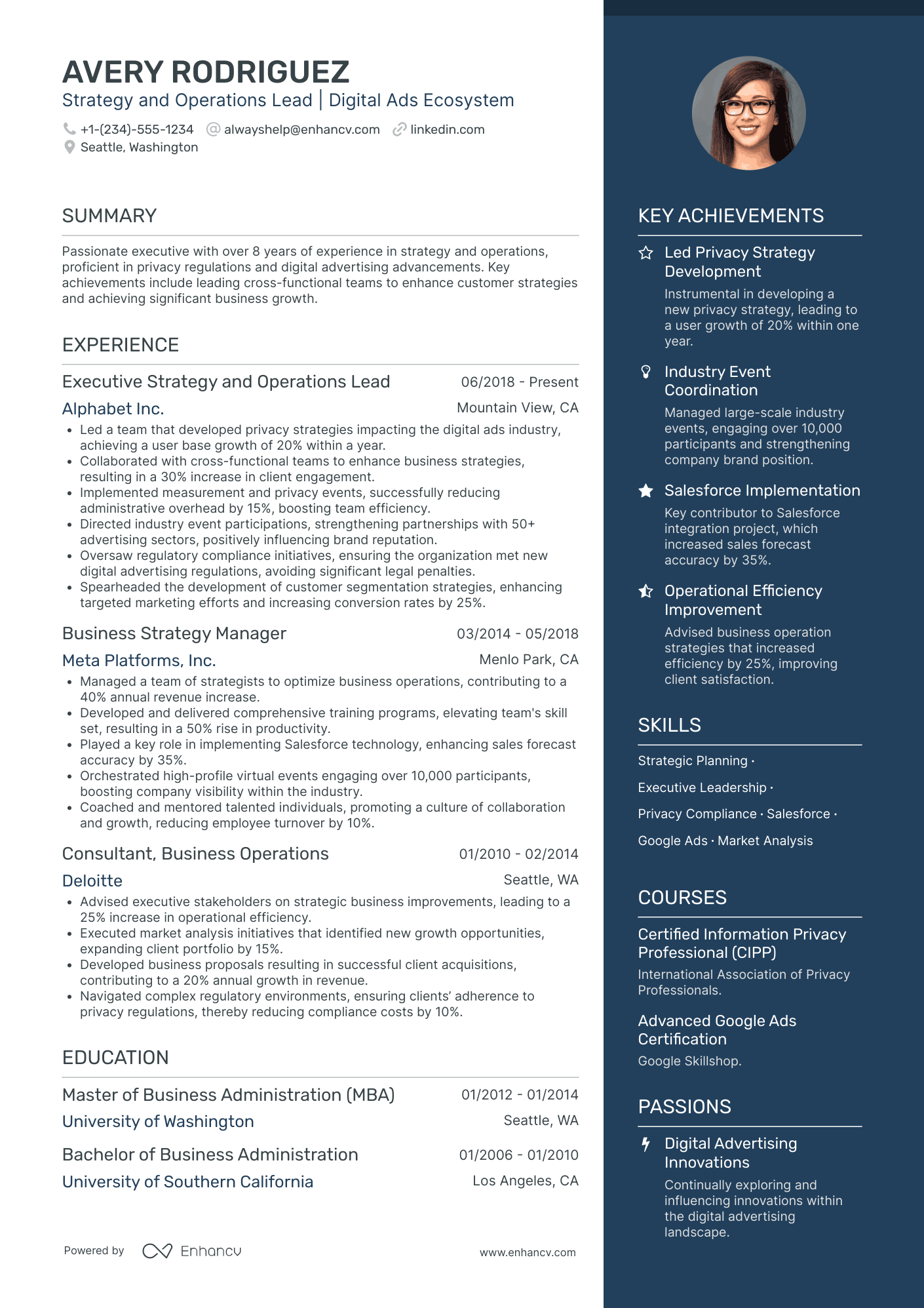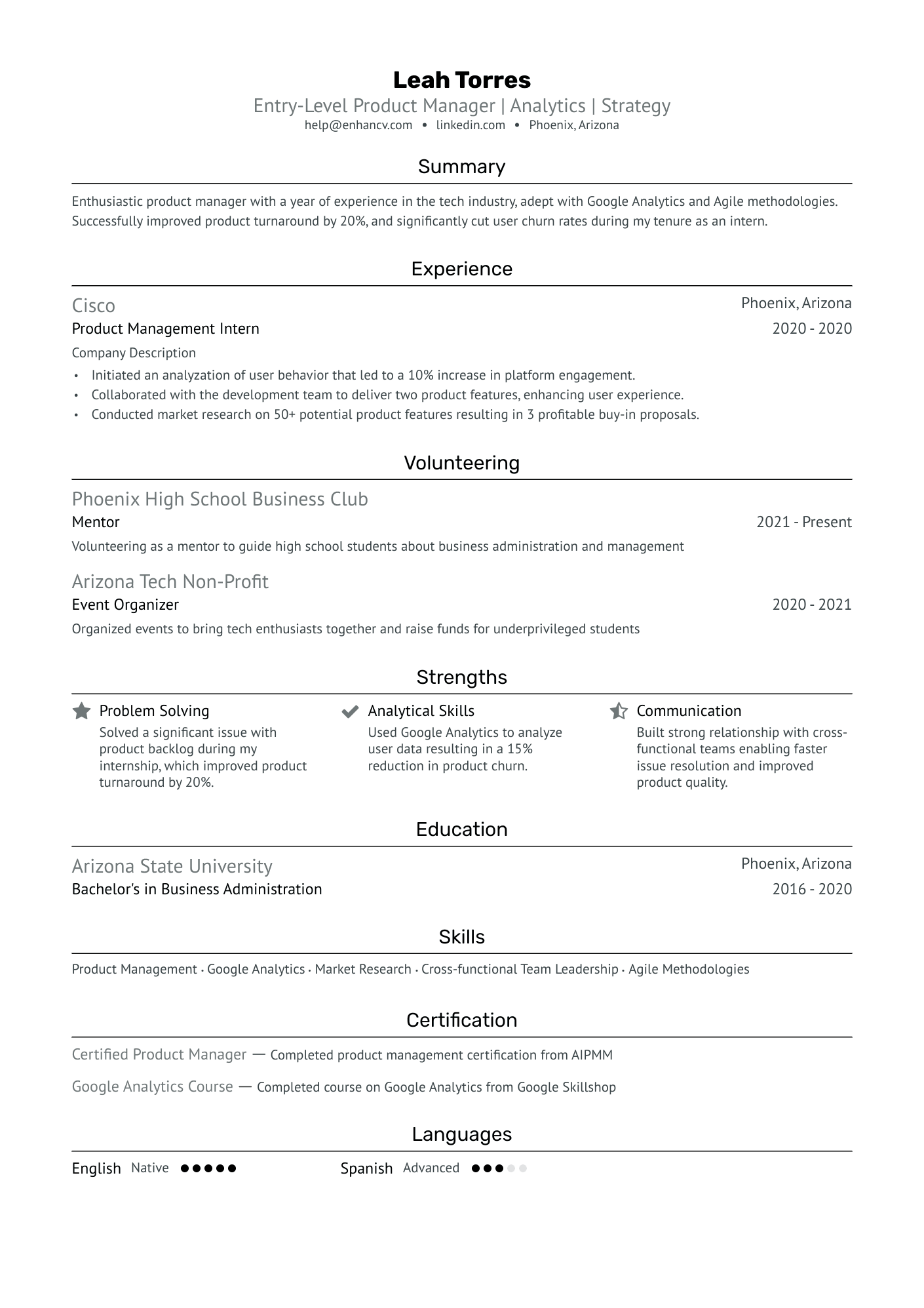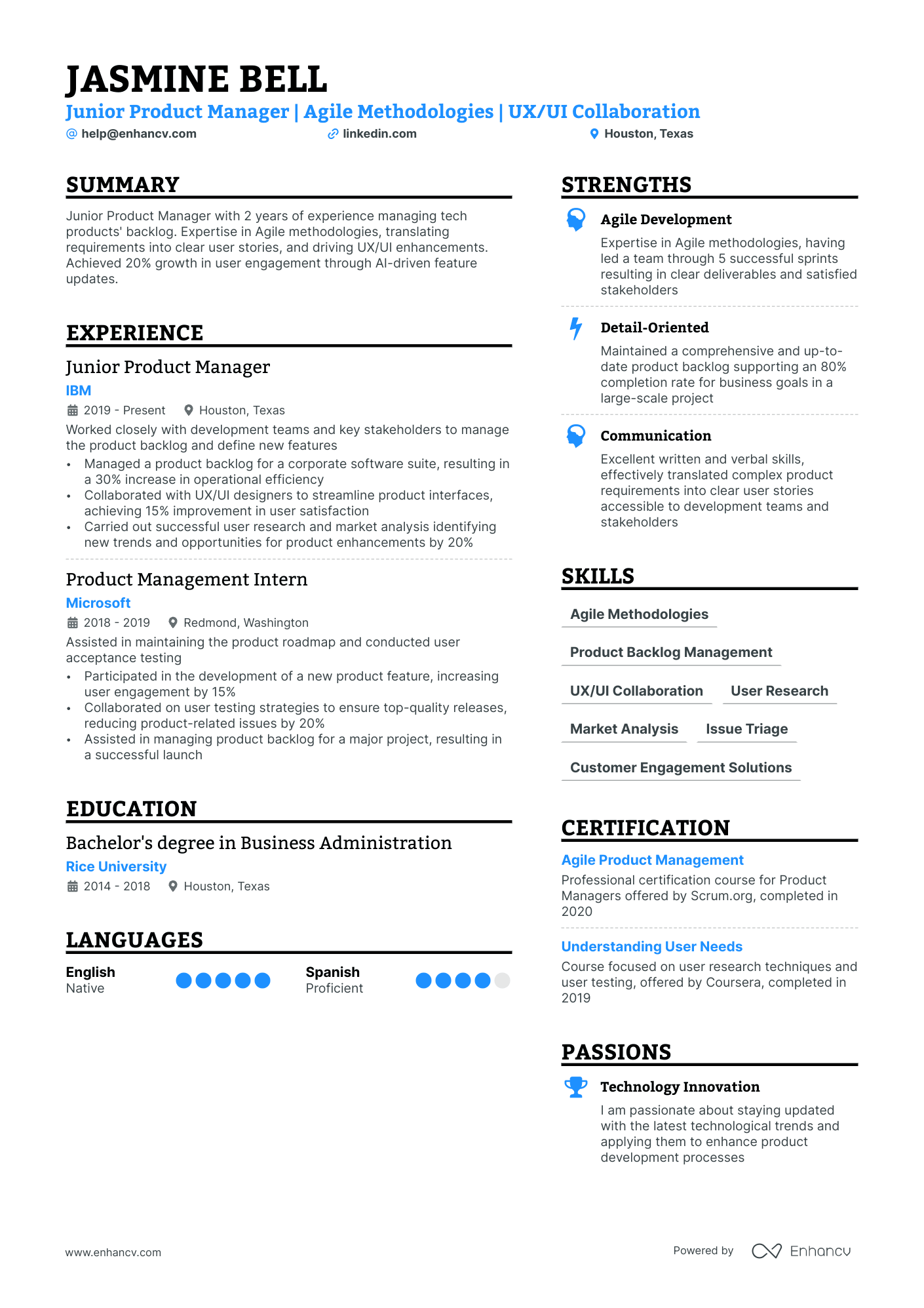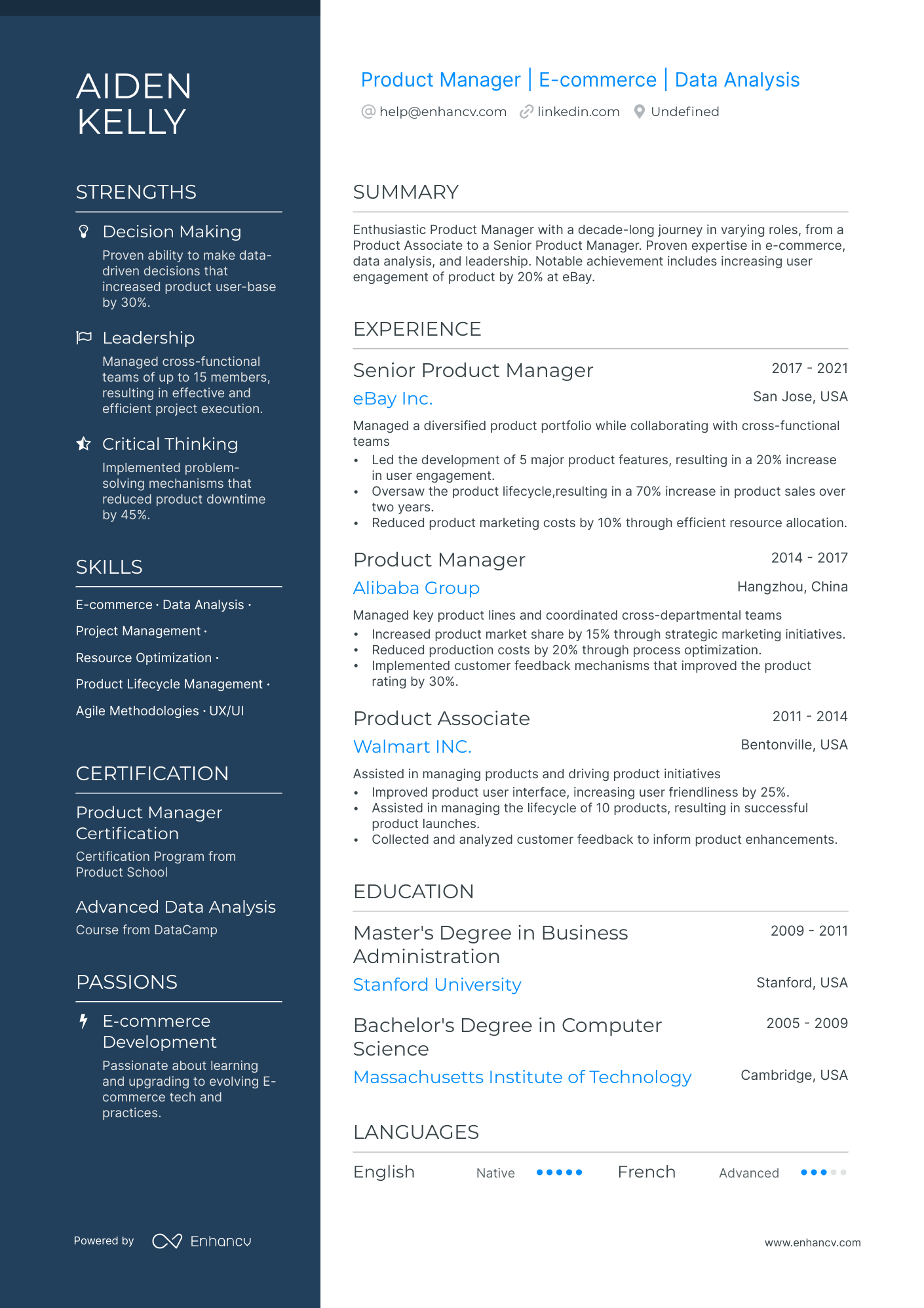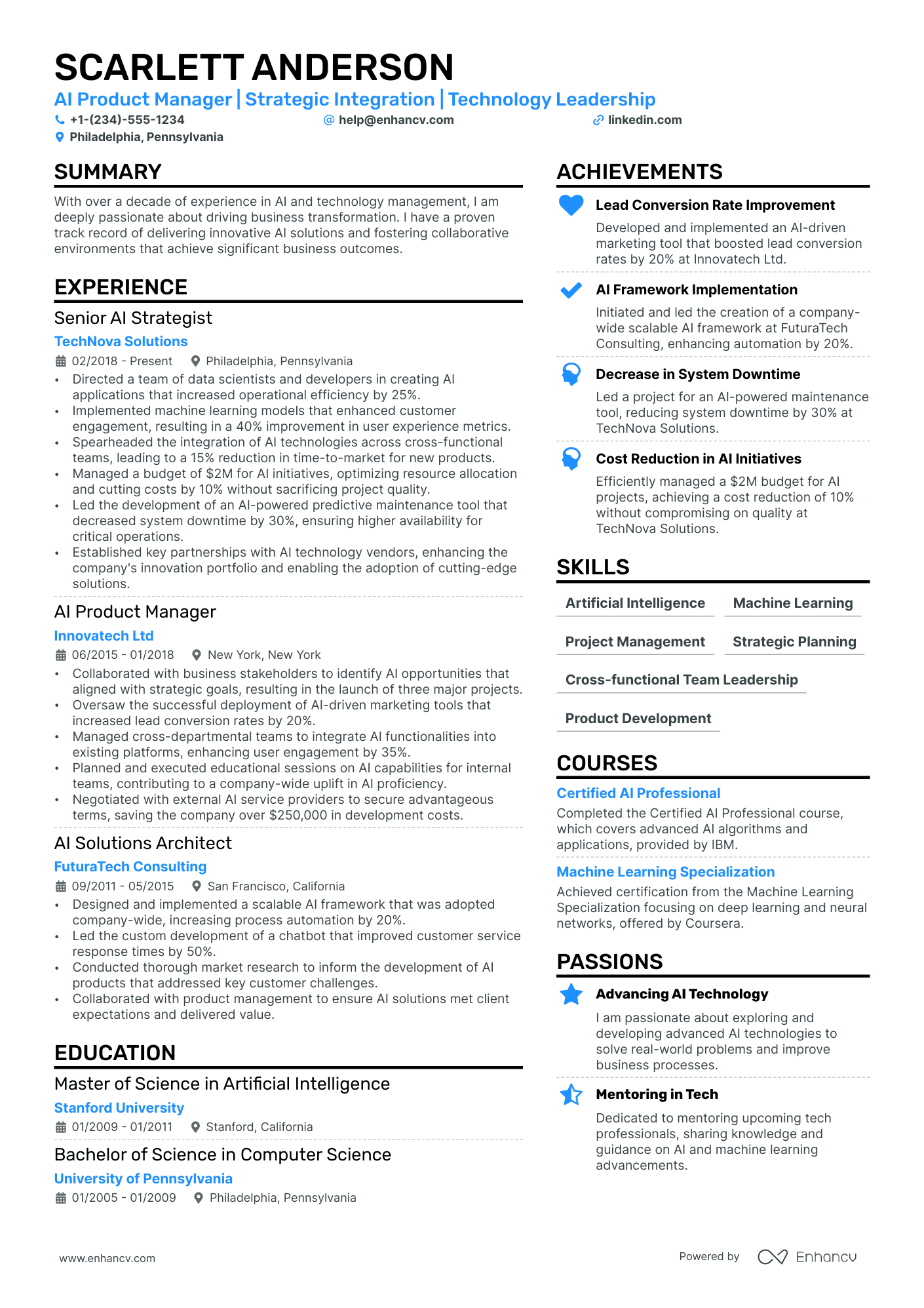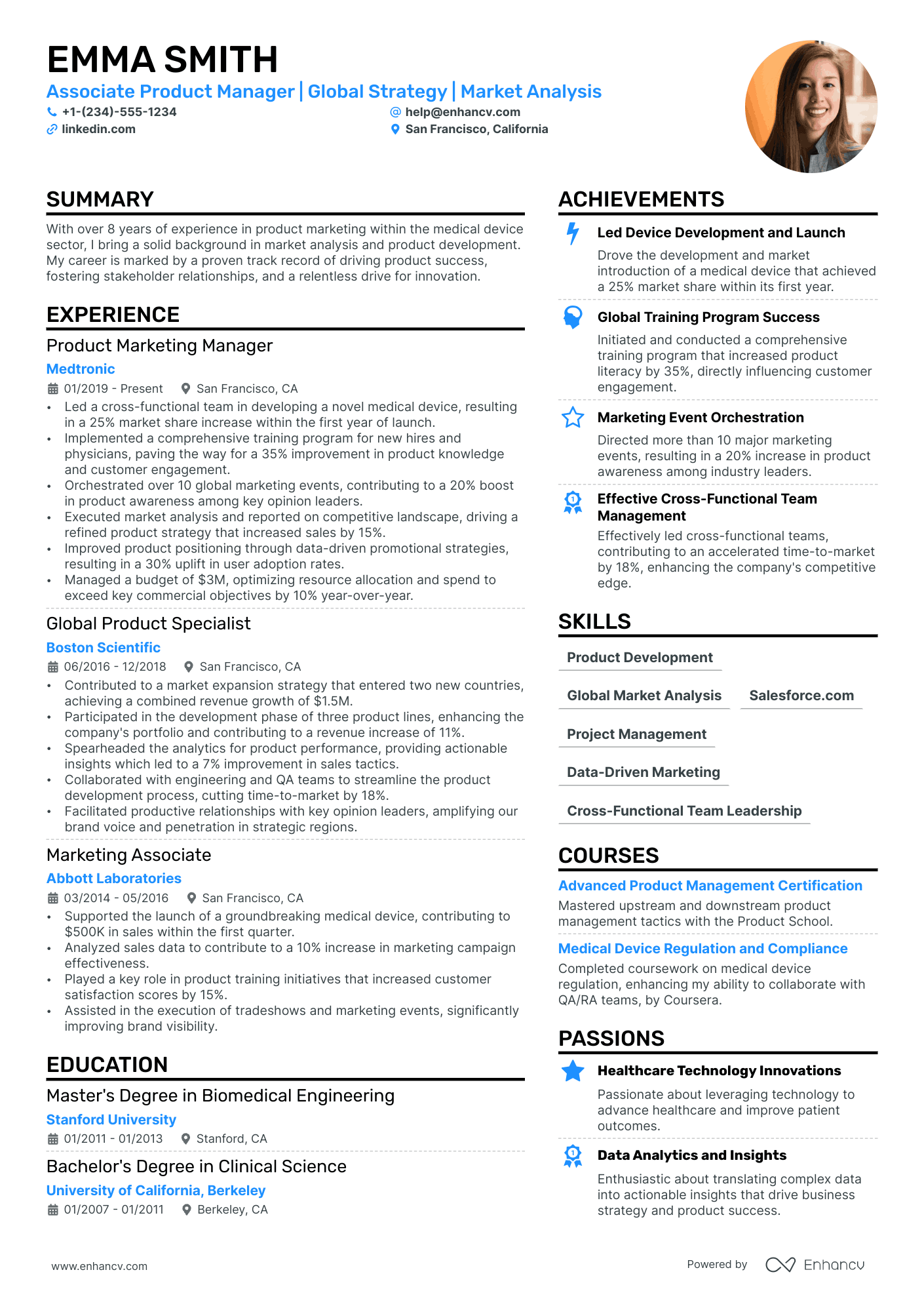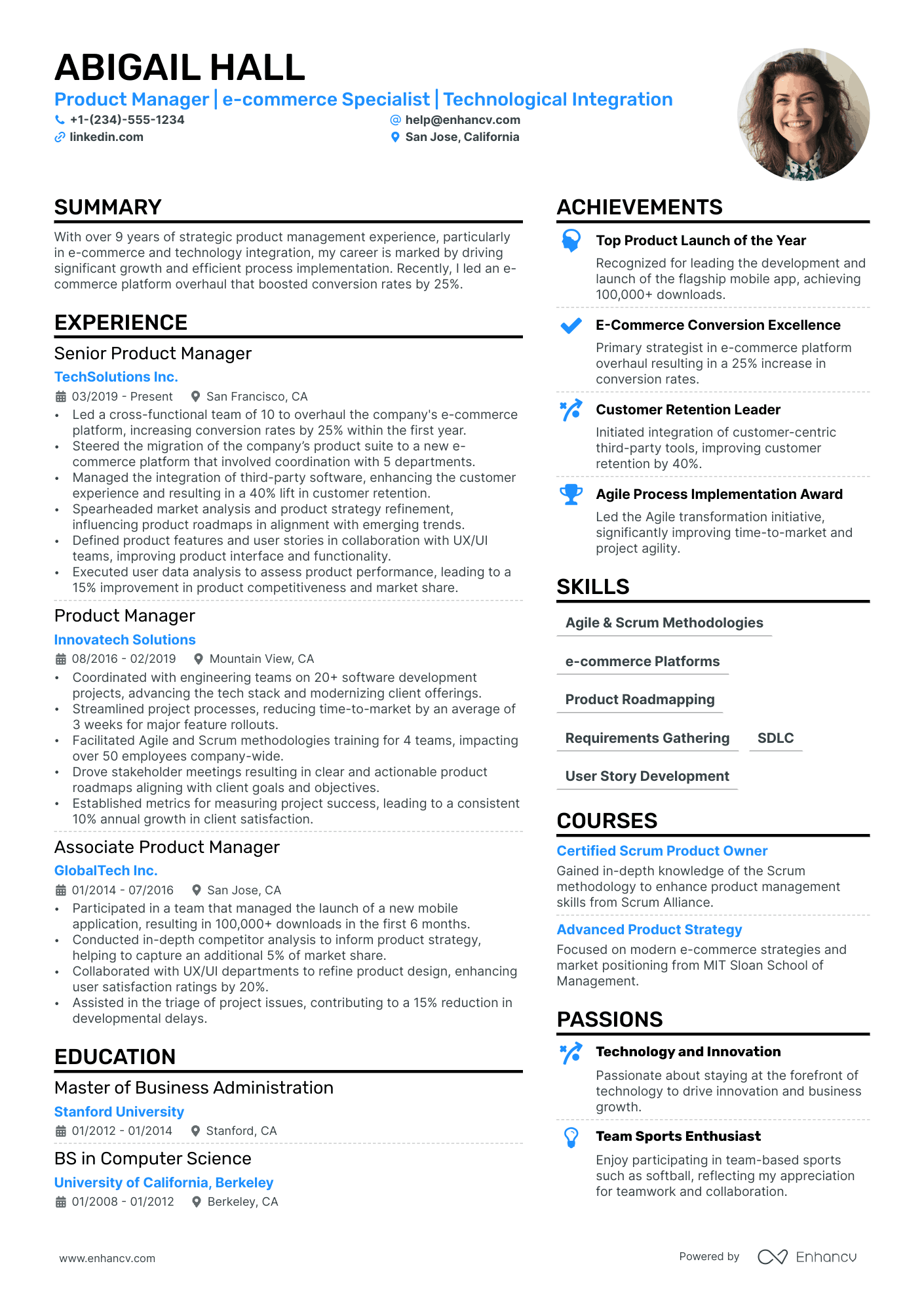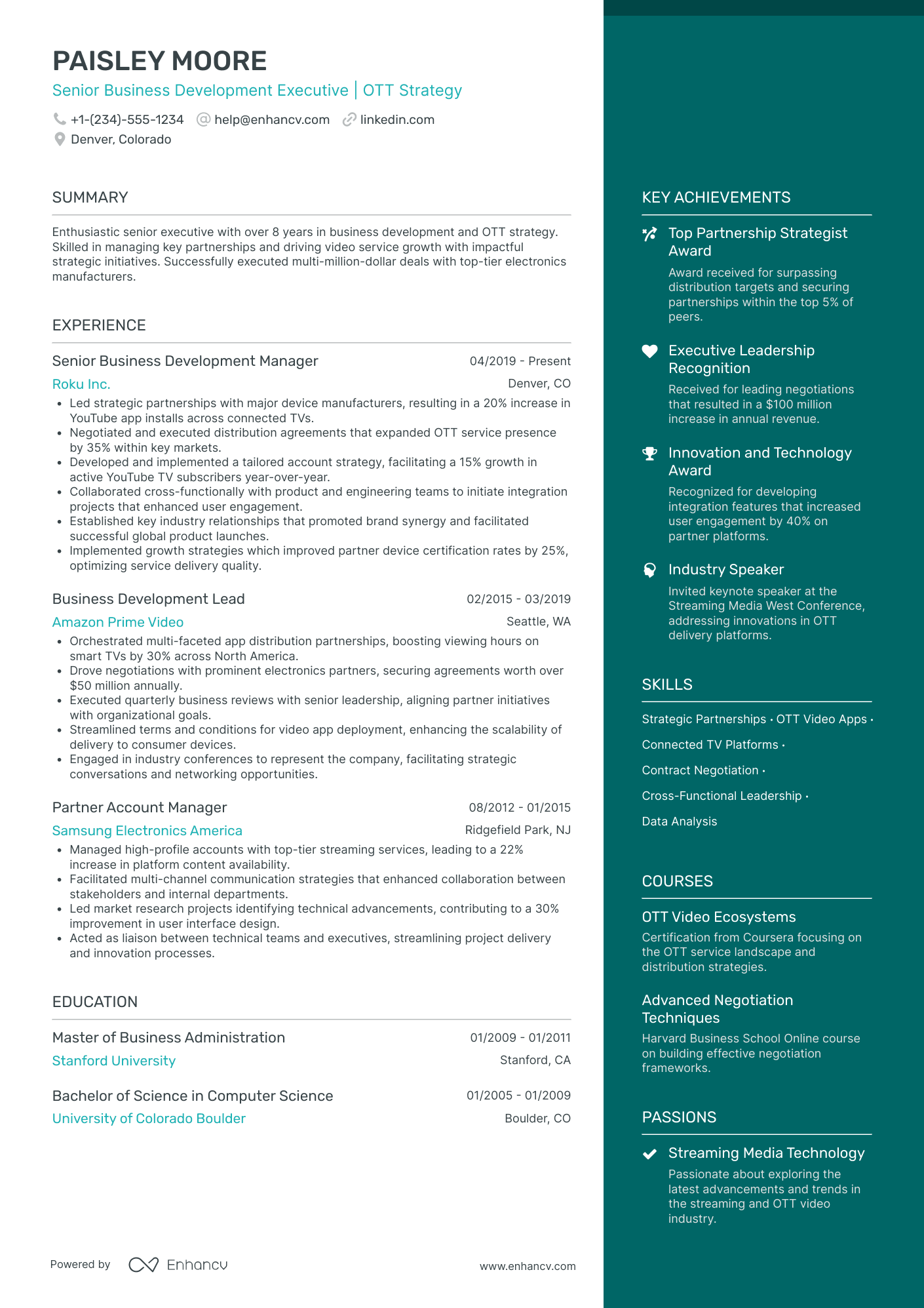Writing a product manager resume requires you to prove how your work has driven growth, improved user experience, and aligned with business goals.
Whether you’re targeting a FAANG giant or an agile startup, this guide will show you how to make your application stand out to both recruiters and AI-powered screening tools.
Product Manager resume examples
By Experience
By Role
Product manager resume template
When creating this editable product manager resume sample, I made it my goal to clearly demonstrate how I’ve driven success and delivered measurable results that impact the bottom line. I’ve highlighted key achievements, leadership examples, and quantifiable outcomes so any hiring manager can quickly see the value I bring to the role.
Let’s take the experience section and break it down.
I focused on writing each bullet to contain quantifiable outcomes (+25% market penetration, +40% satisfaction, +20% transactions, +30% engagement) and clearly tied it to the role.
More examples from this resume include:
- Cross-company PM experience at Plaid, Stripe, and Salesforce.
- Combination of strategy + technical execution (roadmapping, UX, agile, GTM).
- Fintech specialization backed by leadership in financial product launches.
- Dual-language capability for English and Spanish markets.
If you already have your product manager resume ready and want to see how it scores against ATS systems, use Enhancv’s free AI Resume Checker. It reviews 16 key points to improve it and help you get more interviews.
Is your resume good enough?
Drop your resume here or choose a file. PDF & DOCX only. Max 2MB file size.
How to write a product manager resume
Follow these steps to craft a compelling product manager resume that showcases your value and gets the attention of hiring managers.
1. Pick the right resume format
Experienced product managers should go with a chronological resume format as it allows you to showcase work experience front and center. If you’re just starting out, a hybrid resume format is a better option as it’ll help you showcase your strengths and skills better, taking precedence over a lack of work experience.
Condense your work experience and professional accomplishments onto one page when possible. Opt for two pages only if you have over 10 years of experience. Ensure the most important details appear on the first page. Condense your resume if it goes beyond two pages by removing content that doesn’t directly highlight your qualifications or align with what recruiters value most in a product manager.
Enhancv resume templates support the three main options for organizing a product manager resume:
- Reverse-chronological resume: Perfect for those with extensive experience in product management, this format lists your past jobs starting from the most recent and working backward.
- Functional resume: This format is excellent if you're new to product management, transitioning careers, just starting out, or have gaps in your employment history. It emphasizes your skills over your past job roles.
- Hybrid resume: This type of resume combines the strengths of both chronological and functional formats. It lets you show your most important skills and achievements at the start, followed by a short job history. This is really effective for underlining experiences that are directly relevant to the product manager role you're aiming for.
PRO TIP
Save your resume as a PDF. Our resume builder does this by default because it keeps the layout of your resume consistent and is compatible with ATS.
Showcase your product manager experience in must-have resume sections like your summary and experience
Remember to showcase the key sections of your product manager resume:
- A professional summary helps you quickly outline qualifications and what the candidate can bring to the role of product manager.
- Key skills & competencies are vital to highlight relevant hard and soft skills, preferred methodologies, and any technical proficiency required.
- Product management experience that illustrates previous roles held, emphasizing duties and achievements that directly relate to product management.
- Educational qualifications, like your education and certifications, can showcase foundations in business, management, or technology.
- References or referee details with credible references from past roles or academic experiences can further establish a candidate's capability and reliability for the product manager role.
2. Write a work experience section on your product manager resume that shows your impact
When writing your experience section, stick to three to four bullet points beneath each role and focus on specific examples that demonstrate your success. This is even more important when applying for a job as an IT product manager.
A strong product manager's resume experience section shows measurable accomplishments and steady career growth.
Having a career trajectory that goes from startups to FAANG makes you a good candidate. But recruiters want to see how you got there, the goals you achieved, and what you did for the company.
Let’s take a look at how to convey that in your experience section’s bullets.
Good example of a product manager resume experience section
- Achieved 40% product revenue growth in three months by planning and launching four new key features.
- Improved user activation rate by 200% and boosted conversions to premium plans by 60% by strategizing and implementing a new user onboarding flow.
- Conducted 500+ customer interviews for product feedback, with suggested improvements leading to a 99.6% customer satisfaction level.
- Presented market research, competitive positioning, pricing, and revenue models to key stakeholders.
This example experience section works because it includes measurable data and the specific examples show a positive impact. Using real percentages and statistics makes it stand out from other candidates, as quantitative data adds more trust and confidence in your abilities.
It’s also important to carefully curate what experience you show. If you have the good problem of too many achievements to choose from, include the ones that make you most qualified for your target job. Too many statistics can feel overwhelming even to recruiters.
It’s worth mentioning that Enhancv provides professionally designed, ATS-friendly resume templates that can help you organize your experience.
Use specific metrics to make your resume experience section quantifiable
As a product manager, you should highlight measurable results to prove your value in product development and market growth.
Here’s how you can do that:
- Number of projects managed:“Managed 8 cross-functional product initiatives.”
- Team size led: “Led a 12-person engineering and design team.”
- Project budget managed: “Oversaw $2M annual product development budget.”
- Sales or revenue growth: “Increased product revenue by 25% year-over-year.”
- Number of products launched: “Launched 5 new SaaS products to market.”
- User engagement growth: “Boosted active users by 40% within 6 months.”
Even if you lack direct product management experience, quantifying achievements in leadership, strategy, or execution shows clear impact and strengthens your positioning for PM roles.
3. Showcase your hard and soft skills
Tailor your skills section to the job description. Highlight hard skills in both a dedicated section and within your work history for emphasis. Weave soft skills like leadership or communication into your summary, experience, or education entries, where examples can show them in action.
Best hard skills for your product manager resume
- Product roadmap development
- Agile methodologies (Scrum, Kanban)
- Financial modeling & forecasting
- Product pricing strategy
- Go-to-market strategy & launch planning
- User onboarding design & optimization
- Software engineering fundamentals
- Product analytics & growth metrics tracking
- Customer interview & feedback analysis
- UX/UI design principles
- Feature prioritization based on data and user feedback
- Product demo creation (PowerPoint, Keynote)
Remember to only include hard skills you can confidently discuss in an interview. Avoid padding your list with tools or coding languages you can’t use in practice.
Best soft skills for your product manager resume
- Written and verbal communication
- Stakeholder presentation and management
- Leadership and team guidance
- Analytical thinking and problem-solving
- Time management and prioritization
- Cross-functional collaboration
- Market and competitive research
- Risk management
4. Highlight your certifications and education
Your education section and certifications show employers you have both the foundational knowledge and the specialized skills to succeed in product management. If you have a GPA above 3.5, be sure to include it, along with any academic honors such as cum laude or Dean’s List. You can also list relevant coursework to highlight classes that directly support your project management expertise.
These details can strengthen your credibility—especially if you’re early in your PM career or transitioning from another field.
Good example of an education section
Master of Business Administration (MBA)
University of California, Berkeley - Berkeley, CA
Graduated: May 2020 | GPA: 3.8
- Concentration: Project Management & Operations
- Beta Gamma Sigma Honor Society (top 10% of business graduates)
- Relevant Coursework: Strategic Project Management, Agile Methodologies, Data-Driven Decision Making, Operations Strategy
Bachelor of Science in Civil Engineering
University of Michigan - Ann Arbor, MI
Graduated: May 2016 | GPA: 3.7
- Dean’s List, 6 semesters
- Senior Capstone Project: Led a 5-member team in designing a cost-efficient urban development plan, presented to faculty and city planners
- Relevant Coursework: Project Scheduling & Cost Control, Risk Management, Systems Engineering, Leadership in Engineering
If you hold multiple certifications, list the most recent or most relevant first. Place the section that’s most relevant to the job—education or certifications—higher on your resume.
Make sure your certifications are spelled out in full, not just acronyms (including dates). This will help Applicant Tracking Systems (ATS) recognize them if the recruiter has filters set on their part.
Best certifications for your product manager resume
- Certified ScrumMaster (CSM) proves expertise in Agile leadership and Scrum methodology.
- Product Management Certification (PMC) covers strategy, roadmaps, and go-to-market planning.
- Professional Scrum Product Owner (PSPO) focuses on maximizing product value in Agile environments.
- Lean Six Sigma Green Belt (LSSGB) demonstrates process improvement and efficiency skills.
5. Craft a resume summary that makes you stand out
Open your product manager resume with a short, high-impact summary that highlights your top skills, biggest wins, and industry expertise. Keep it to about three sentences, weaving in relevant keywords from the job posting.
For most product managers, a summary works better than a resume objective. It gives recruiters a quick snapshot of your background, achievements, and leadership style.
Good example of a product manager resume summary
Product Manager with 9+ years in fast-paced tech environments, leading product strategy and development. Increased user engagement by 30% and revenue by 20% through data-driven decision-making. Skilled in advanced analytics tools and cross-functional leadership, delivering a 25% boost in product performance.
Optimize your product manager resume summary for ATS
Drop your resume here or choose a file.
PDF & DOCX only. Max 2MB file size.
Additional tips when building your product manager resume
Small design choices can make a big difference in how your application is perceived. From font and color to template layout, these resume tips will help you create a document that’s both ATS-friendly and visually appealing.
What font, colors, and template design should I use for my product manager resume?
When making your product manager resume:
- Opt for a modern resume template to show your innovative style as a product manager.
- Choose readable fonts like Rubik, Lato, or Times New Roman, sized between 10 and 12 points for clarity.
- Maintain at least 1-inch margins around your resume for a tidy presentation.
- Use professional colors like gray, blue, or dark green for accents.
- Always include your name, phone number, and a professional email address.
- Insert a link to your LinkedIn profile if relevant and ensure it’s up-to-date.
- Include a photo only if the job advertisement specifically asks for one.
Align your resume with the market’s standards: Canadian resumes may have unique layout guidelines.
How do I write a product manager resume with no experience?
For entry-level product managers lacking work experience, your new perspective and degree are valuable starting points. It's important to remember that personal qualities are just as essential as technical skills.
Here's how to structure your resume when you don’t have product manager experience:
- Educational insights: Begin by emphasizing your educational achievements, especially focusing on any courses or certifications related to product management or related fields. This will help you lay down a solid knowledge base.
- Value beyond experience: Include sections on projects, volunteer activities, or freelance work that relate to product management or demonstrate relevant skills. These experiences showcase your ability to contribute value from day one.
- Transferable skills: In the experience section, accentuate transferable skills such as communication, creativity, analytical thinking, and project management. These are vital for a product manager and illustrate your readiness for the role.
- Practical engagements: Mention any internships or academic projects that involve product management tasks, even if unpaid. These experiences provide tangible evidence of your practical skills in the field.
What additional section can I include on my product manager resume?
For product management roles, emphasize both technical and soft skills and include these sections in your resume:
- Courses will help you demonstrate continuous learning in product management and related fields.
- Volunteer work showcases your leadership and teamwork skills developed in non-work settings.
- Awards recognize achievements and excellence in product management or related areas.
- Passions mention your personal hobbies and interests outside the office, like reading or hiking. They underscore your creativity and enthusiasm for product management, matching well with a company’s culture.
How to put a projects section on a product manager resume?
Hiring managers and executives like to see direct examples of your work. They need to determine if your approach to product management and your strategic capabilities are a good fit for their ongoing projects.
Enhancv offers a “Projects” resume section in our resume builder that you can use to structure your projects like so:
Good example of a “Projects” section in a product manager resume
Digital Product Innovation Initiative
Managed a comprehensive digital product innovation project, focusing on market-driven strategies and user-centric design to enhance business operations and expand product offerings.
- Led a major initiative to develop and launch a suite of digital products, increasing market share by 40% within a highly competitive sector.
- Directed cross-functional teams in a user-centered design process, ensuring product features aligned with customer needs and market trends.
- Implemented agile project management practices to streamline product development cycles, resulting in a 30% faster time-to-market for new features.
What’s the average salary for a product manager in the US?
Top 10 salaries for a product manager by state
| State | Salary |
|---|---|
| California | $123,009 |
| Washington | $107,415 |
| New York | $105,501 |
| Oregon | $101,163 |
| New Jersey | $100,492 |
| Nevada | $98,840 |
| Rhode Island | $98,790 |
| Virginia | $96,760 |
| Massachusetts | $96,701 |
| Arizona | $96,587 |





